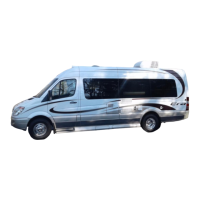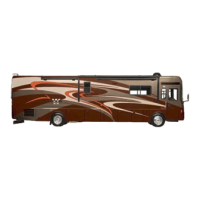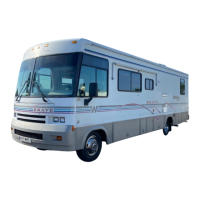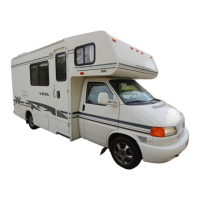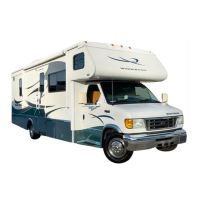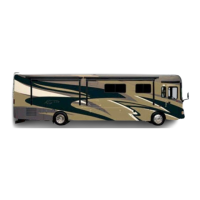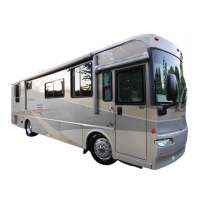Do you have a question about the Winnebago ERA and is the answer not in the manual?
Explains the purpose and scope of the operator's manual.
Details safety alert symbols (Danger, Warning, Caution, Notice) and their meanings.
Explains vehicle identification numbers and important reference information on the label.
Provides detailed dimensions, weights, and capacities for different models.
Lists essential safety rules for vehicle occupancy and operation.
Provides critical safety checks and precautions to perform before driving the motorhome.
Covers safety warnings and precautions for operating the fuel and propane gas systems.
Explains the function of the Carbon Monoxide (CO) Alarm and its detection capabilities.
Details the location, inspection, and replacement of the dry chemical fire extinguisher.
Explains how driver and co-pilot seats can be adjusted for individual preference.
Details the quick-release pedestal operation for removing and installing companion seats.
Details proper use, fastening, release, and care of lap/shoulder belts for safety.
Provides guidelines for selecting, installing, and using child restraint systems safely.
Describes the features and functions of the vehicle's collision avoidance system.
Covers the all-in-one system for dash radio, rearview monitor, and GPS.
Explains operation of the refrigerator on 120V AC, 12V DC, or propane gas, and leveling.
Details the panel for checking utility systems like water levels, propane, and battery condition.
Describes the system providing continuous hot water and interior heat from LP gas or 120V current.
Explains the dual power operation of the water heater for propane gas or 120-volt current.
Guides on starting up, shutting down, and troubleshooting the propane gas furnace.
Explains cooling operation, including fan speed and temperature control settings.
Details the propane system's function for appliances and its safe, economical use.
Outlines safety precautions, devices, and the odor additive for propane gas system use.
Explains the regulator's protection, installation, and potential freeze-up issues.
Warns about hazards of handling electrical components, improper grounding, and overloading.
Provides instructions and warnings for connecting the external power cord to utility services.
Explains the function of the power converter panel with circuit breakers and fuses.
Covers generator operation, warnings, and basic procedures for starting and stopping.
Provides essential advice on maintaining lead-acid batteries to prevent sulfating and ensure proper function.
Describes the system providing water to fixtures and its filling methods (City/Gravity).
Explains how the demand pump supplies water from the tank and its self-priming function.
Details the filter for drinking water, its replacement schedule, and installation.
Provides a step-by-step procedure for sanitizing the potable water system.
Explains the self-contained drainage system with two holding tanks for waste water.
Outlines two methods (blow-out or antifreeze) for winterizing the water and plumbing system.
Explains the 12-volt LED TV operation, power source, and speaker selection.
Details the swivel mechanism allowing TV viewing inside or outside the vehicle.
Covers the multi-featured audio system including DVD/CD/MP3 player and sound output options.
Guides on operating the digital antenna for clear over-the-air channel reception.
Locates the cable television input connection in the water service center.
Instructions for setting up and storing the dining table and its pedestal.
Covers conversion of twin beds to a full-size sleeping area.
Details how to convert the sofa into a bed and its countertop extension.
Explains how to remove and install the removable wardrobe cabinet for storage.
Discusses the types of wood used and their natural characteristics.
Explains the requirements for operating slideout rooms, including ignition and brake.
Details how to extend and retract slideout rooms using electric mechanisms.
Provides instructions for manually overriding the slideout mechanism if it malfunctions.
Offers advice on cleaning seals and floors for smooth slideout room operation.
Emphasizes regular inspection and maintenance of sealants to prevent water entry.
Provides precautions for maintaining the gel-coated fiberglass finish for gloss and durability.
Guides on cleaning plastic parts using mild cleaners and avoiding harsh chemicals.
Outlines steps for preparing the vehicle for storage to prevent damage.
Presents a recommended maintenance schedule for various coach systems and components.
Advises on proper weight distribution and securing loose items for safe travel.
Explains how to find a scale and check the coach's weight for proper load distribution.
Covers hitch capacity, tongue weight, and general guidelines for towing vehicles.
Defines Gross Vehicle Weight Rating (GVWR), GAWR, and GCWR for safe towing.
Covers the operation of the power awning, including extension, retraction, and safety precautions.
Explains the purpose and scope of the operator's manual.
Details safety alert symbols (Danger, Warning, Caution, Notice) and their meanings.
Explains vehicle identification numbers and important reference information on the label.
Provides detailed dimensions, weights, and capacities for different models.
Lists essential safety rules for vehicle occupancy and operation.
Provides critical safety checks and precautions to perform before driving the motorhome.
Covers safety warnings and precautions for operating the fuel and propane gas systems.
Explains the function of the Carbon Monoxide (CO) Alarm and its detection capabilities.
Details the location, inspection, and replacement of the dry chemical fire extinguisher.
Explains how driver and co-pilot seats can be adjusted for individual preference.
Details the quick-release pedestal operation for removing and installing companion seats.
Details proper use, fastening, release, and care of lap/shoulder belts for safety.
Provides guidelines for selecting, installing, and using child restraint systems safely.
Describes the features and functions of the vehicle's collision avoidance system.
Covers the all-in-one system for dash radio, rearview monitor, and GPS.
Explains operation of the refrigerator on 120V AC, 12V DC, or propane gas, and leveling.
Details the panel for checking utility systems like water levels, propane, and battery condition.
Describes the system providing continuous hot water and interior heat from LP gas or 120V current.
Explains the dual power operation of the water heater for propane gas or 120-volt current.
Guides on starting up, shutting down, and troubleshooting the propane gas furnace.
Explains cooling operation, including fan speed and temperature control settings.
Details the propane system's function for appliances and its safe, economical use.
Outlines safety precautions, devices, and the odor additive for propane gas system use.
Explains the regulator's protection, installation, and potential freeze-up issues.
Warns about hazards of handling electrical components, improper grounding, and overloading.
Provides instructions and warnings for connecting the external power cord to utility services.
Explains the function of the power converter panel with circuit breakers and fuses.
Covers generator operation, warnings, and basic procedures for starting and stopping.
Provides essential advice on maintaining lead-acid batteries to prevent sulfating and ensure proper function.
Describes the system providing water to fixtures and its filling methods (City/Gravity).
Explains how the demand pump supplies water from the tank and its self-priming function.
Details the filter for drinking water, its replacement schedule, and installation.
Provides a step-by-step procedure for sanitizing the potable water system.
Explains the self-contained drainage system with two holding tanks for waste water.
Outlines two methods (blow-out or antifreeze) for winterizing the water and plumbing system.
Explains the 12-volt LED TV operation, power source, and speaker selection.
Details the swivel mechanism allowing TV viewing inside or outside the vehicle.
Covers the multi-featured audio system including DVD/CD/MP3 player and sound output options.
Guides on operating the digital antenna for clear over-the-air channel reception.
Locates the cable television input connection in the water service center.
Instructions for setting up and storing the dining table and its pedestal.
Covers conversion of twin beds to a full-size sleeping area.
Details how to convert the sofa into a bed and its countertop extension.
Explains how to remove and install the removable wardrobe cabinet for storage.
Discusses the types of wood used and their natural characteristics.
Explains the requirements for operating slideout rooms, including ignition and brake.
Details how to extend and retract slideout rooms using electric mechanisms.
Provides instructions for manually overriding the slideout mechanism if it malfunctions.
Offers advice on cleaning seals and floors for smooth slideout room operation.
Emphasizes regular inspection and maintenance of sealants to prevent water entry.
Provides precautions for maintaining the gel-coated fiberglass finish for gloss and durability.
Guides on cleaning plastic parts using mild cleaners and avoiding harsh chemicals.
Outlines steps for preparing the vehicle for storage to prevent damage.
Presents a recommended maintenance schedule for various coach systems and components.
Advises on proper weight distribution and securing loose items for safe travel.
Explains how to find a scale and check the coach's weight for proper load distribution.
Covers hitch capacity, tongue weight, and general guidelines for towing vehicles.
Defines Gross Vehicle Weight Rating (GVWR), GAWR, and GCWR for safe towing.
Covers the operation of the power awning, including extension, retraction, and safety precautions.
| Chassis | Mercedes-Benz Sprinter |
|---|---|
| Engine | 3.0L V6 Turbo Diesel |
| Fuel Capacity | 24.5 gallons |
| GVWR | 11, 030 lbs |
| Black Water Capacity | 10 gallons |
| Horsepower | 188 hp |
| Torque | 325 lb-ft |
| Transmission | 5-speed automatic |
| Interior Height | 6'3" |
| Sleeping Capacity | 2-3 |
